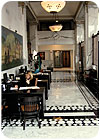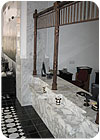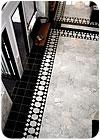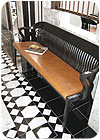
Worthington National Bank - the current tenant of an historic building in Fort Worth, TX - recently restored the interior architecture by relying on old photographs that showed the original design.
The building that today is home to Worthington National Bank of Fort Worth, TX, holds a storied past. Originally built in 1914, the historic landmark was first occupied by a bank, and then housed a string of various tenants throughout the years. And due to the toll of time and lack of upkeep, the once-elegant interior marble work was in a state of disrepair. But through the recent efforts of Worthington National Bank President Greg D. Morse and a team of design experts, the stonework has been restored to its original grandeur.
“With the southwest regional headquarters of the National Historic Registry in our office building, we had a responsibility to make things historically accurate,” stated Morse, who personally has an interest in restoration and a community-related approach to business. Those involved in the restoration project relied on old photographs of the original bank to make the design as accurate as possible.

In areas where the white marble had discolored, the stone was cleaned to bring back its original luster.
The architect also explained that in areas where the white marble discolored over time, a restoration crew worked to clean it. Additionally, all of the ceiling and the details at the top of the columns were restored.
“We tried to match everything as close as possible,” she said. “The columns originally had 8- or 9-inch bases, but over the years they had broken. We had to redo them. [Also], the original pictures show that the ceiling is made of brick, but it is now covered with plaster.”

At the heart of the building’s original design were the artisan-cut black-and-white marble floors.
Replicating an old art form
At the heart of the original design was an artisan-cut, black-and-white marble floor. Reproducing the intricate geometric pattern posed a unique challenge to the design team, as they questioned the feasibility of recreating the flooring by hand as it had originally been executed. They feared that producing the original flooring with traditional tile saws would be costly, and also worried that they would not provide the required accuracy that was needed.“As far as the floor goes, we tried to replicate it the best we could from the original drawings,” said Fernandez. “We made up an actual floor plan, and did a pattern of the floor. They were hexagon pieces - usually [floors like this are] diamond or square or triangle. We knew it would be costly, but fortunately the owner felt very strongly about replicating the floor and bringing it to the original look.
“This particular owner has done another bank,” Fernandez went on to explain. “It was an old post office. He’s really into restoration, and realizes the expense is worth it.”

To meet the demands that were needed for this particular job, the design team relied on the expertise of Waterjet Works, a specialized fabricator in Dallas, TX, and its company president, Philip Einsohn, to reproduce the marble floor. “Cutting stone by hand is somewhat of a lost art,” stated Bank President Greg D. Morse. “Therefore, we used Waterjet Works to accurately cut the stone for our floor.”
The waterjet fabricator had to ensure that each piece would fit correctly. If it did not, the entire project would not work. “A fraction of an inch over 100 feet made all the difference in the success of the flooring,” said Fernandez. “Having the ability to cut the marble precisely was important.”
Once the details of the design were in place, it only took Waterjet Works several weeks to fabricate the marble pieces. The floor was then repaired and prepared by Business Flooring Specialists.
“When we were asked to participate in this restoration project, I knew it would require a team effort,” said the architect. “Most floors in older buildings require a great deal of work to restore them to modern standards. Working with Waterjet Works allowed us to not waste time cutting parts on the jobsite. With extremely small grout lines, we knew our focus on floor preparation would be the ‘make or break’ aspect of a successful flooring installation, and we were right.”

It only took the waterjet fabricator several weeks to reproduce the marble floor tiles. The entire restoration was completed in approximately eight months.
But in the end, all those involved were pleased with the final results. “I can assure you that no one enters this bank without commenting on our marvelous floor,” stated Morse. “They all ask, ‘How did they do such accurate work? ‘ “
Worthington National Bank Building
Fort Worth, TX
Owner:Sundance Square, Fort Worth, TXArchitect:CHS Architects, Fort Worth, TX
Stone Fabricator:Waterjet Works, Dallas, TX
Restoration Contractor:Business Flooring Specialists
